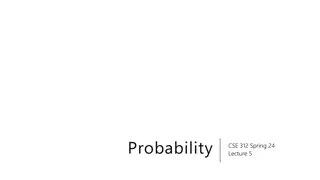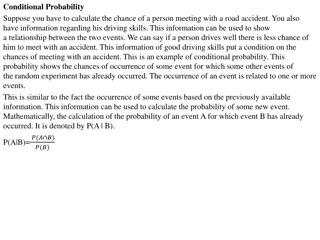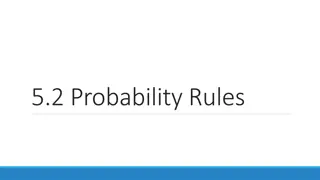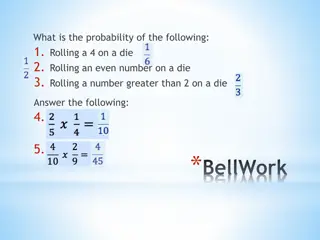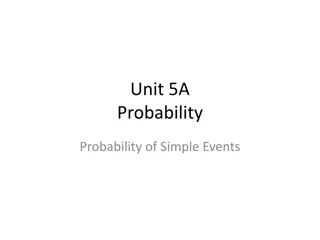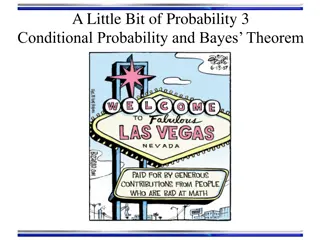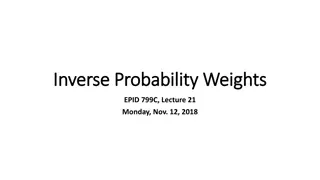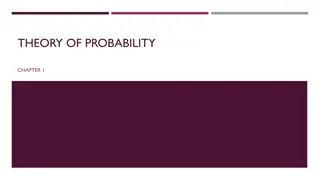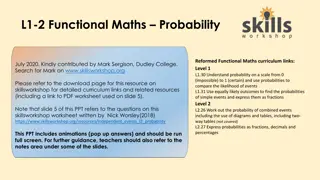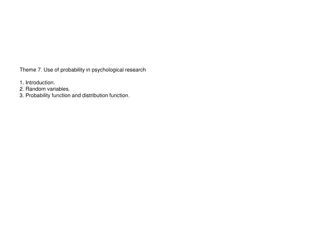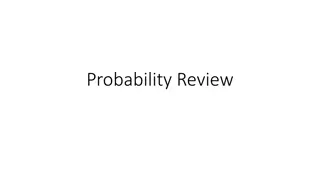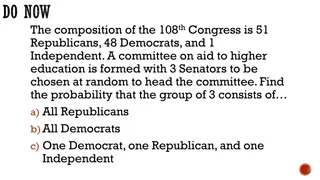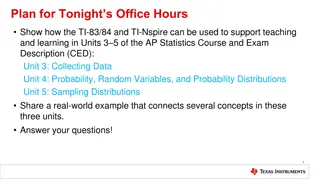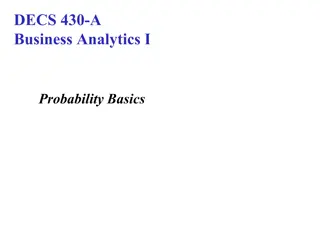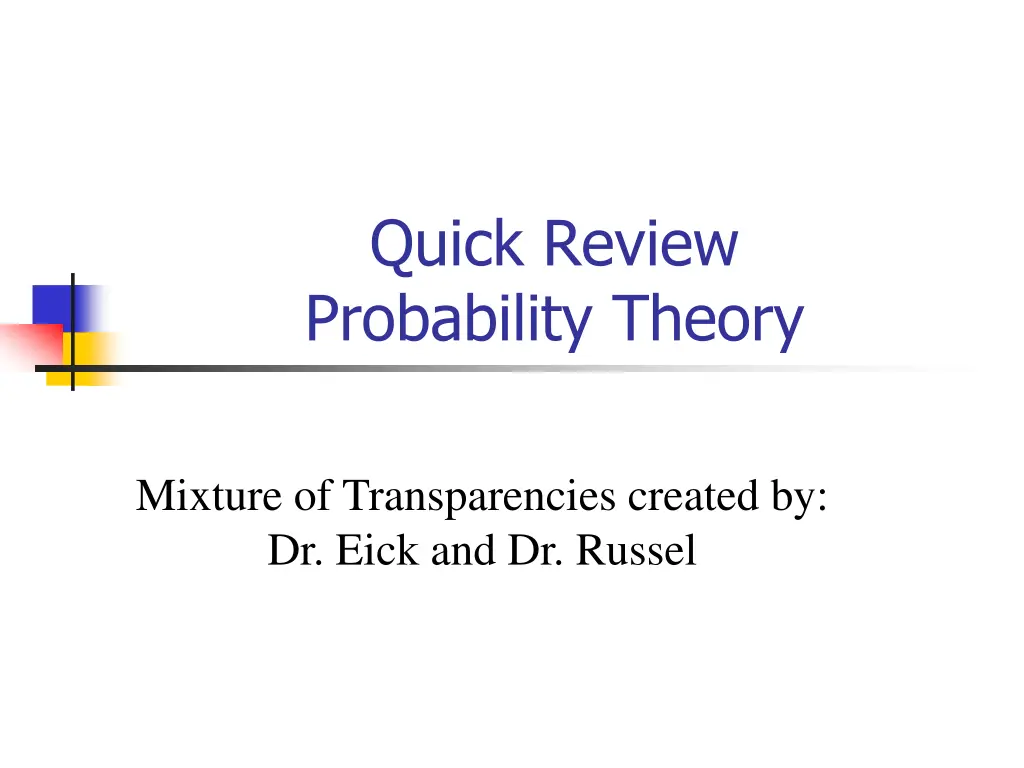
Understanding Probability Theory and Decision Making Under Uncertainty
Explore Probability Theory, Bayes Theorem, Belief Networks, and more in this comprehensive guide. Learn about random variables, sample space, events, and the laws of probability to enhance your reasoning and decision-making skills.
Download Presentation

Please find below an Image/Link to download the presentation.
The content on the website is provided AS IS for your information and personal use only. It may not be sold, licensed, or shared on other websites without obtaining consent from the author. If you encounter any issues during the download, it is possible that the publisher has removed the file from their server.
You are allowed to download the files provided on this website for personal or commercial use, subject to the condition that they are used lawfully. All files are the property of their respective owners.
The content on the website is provided AS IS for your information and personal use only. It may not be sold, licensed, or shared on other websites without obtaining consent from the author.
E N D
Presentation Transcript
Quick Review Probability Theory Mixture of Transparencies created by: Dr. Eick and Dr. Russel
Reasoning and Decision Making Under Uncertainty 1. Quick Review Probability Theory 2. Bayes Theorem and Na ve Bayesian Systems 3. Bayesian Belief Networks Structure and Concepts D-Separation How do they compute probabilities? How to design BBN using simple examples Other capabilities of Belief Network short! Netica Demo Develop a BBN using Netica likely Task6 4. Hidden Markov Models (HMM)
Causes of not knowing things precisely Default Logic and Reasoning If Bird(X) THEN Fly(X) Incompleteness Uncertainty Belief Networks Vagueness Bayesian Technology Fuzzy Sets and Fuzzy Logic Reasoning with concepts that do not have a clearly defined boundary; e.g. old, long street, very old
Random Variable Definition: A variable that can take on several values, each value having a probability of occurrence. There are two types of random variables: Discrete. Take on a countable number of values. Continuous. Take on a range of values.
The Sample Space The space of all possible outcomes of a given process or situation is called the sample space S. S red & small blue & small blue & large red & large
An Event An event A is a subset of the sample space. S red & small blue & small red & large blue & large A
Atomic Event An atomic event is a single point in S. Properties: Atomic events are mutually exclusive The set of all atomic events is exhaustive A proposition is the disjunction of the atomic events it covers.
The Laws of Probability The probability of the sample space S is 1, P(S) = 1 The probability of any event A is such that 0 <= P(A) <= 1. Law of Addition If A and B are mutually exclusive events, then the probability that either one of them will occur is the sum of the individual probabilities: P(A or B) = P(A) + P(B)
The Laws of Probability If A and B are not mutually exclusive: P(A or B) = P(A) + P(B) P(A and B) A B
Statistical Independence Example Discussion Population of 1000 students 600 students know how to swim (S) 700 students know how to bike (B) 420 students know how to swim and bike (S,B) In general, between and can swim and bike P(S B) = 420/1000 = 0.42 P(S) P(B) = 0.6 0.7 = 0.42 In general: P(S B)=P(S)*P(B|S)=P(B)*P(S|B) P(S B) = P(S) P(B) => Statistical independence P(S B) > P(S) P(B) => Positively correlated P(S B) < P(S) P(B) => Negatively correlated max(0, P(S)+P(B)-1) P(S B) min(P(S),P(B))
Conditional Probabilities and P(A,B) Given that A and B are events in sample space S, and P(B) is different of 0, then the conditional probability of A given B is P(A|B) = P(A,B) / P(B) If A and B are independent then P(A,B)=P(A)*P(B) P(A|B)=P(A) In general: min(P(A),P(B) P(A)*P(B) max(0,1-P(A)-P(B)) For example, if P(A)=0.7 and P(B)=0.6 then P(A,B) has to be between 0.3 and 0.6, but not necessarily be 0.42!!
The Laws of Probability Law of Multiplication What is the probability that both A and B occur together? P(A and B) = P(A) P(B|A) where P(B|A) is the probability of B conditioned on A.
The Laws of Probability If A and B are statistically independent: P(B|A) = P(B) and then P(A and B) = P(A) P(B)
Independence on Two Variables P(A,B|C) = P(A|C) P(B|A,C) If A and B are conditionally independent: P(A|B,C) = P(A|C) and P(B|A,C) = P(B|C)
Multivariate Joint Distributions P(x,y) = P( X = x and Y = y). P (x) = Prob( X = x) = y P(x,y) It is called the marginal distribution of X The same can be done on Y to define the marginal distribution of Y, P (y). If X and Y are independent then P(x,y) = P (x) P (y)
Bayes Theorem P(A,B) = P(A|B) P(B) P(B,A) = P(B|A) P(A) The theorem: P(B|A) = P(A|B)*P(B) / P(A) Example: P(Disease|Symptom)= P(Symptom|Disease)*P(Disease)/P(Symptom)

